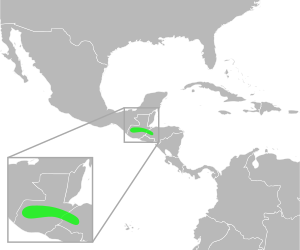Incilius ibarrai facts for kids
Quick facts for kids Incilius ibarrai |
|
|---|---|
| Conservation status | |
| Scientific classification | |
 |
|
| Synonyms | |
|
Bufo ibarrai Stuart, 1954 |
The Incilius ibarrai, also known as the Jalapa toad, is a type of toad that belongs to the Bufonidae family. You can find this toad in the central and southern highlands of Guatemala and nearby Honduras. The name ibarrai was chosen to honor Jorge Alfonso Ibarra (1921–2000). He was the director of the Guatemalan National Natural History Museum at the time.
Contents
About the Jalapa Toad Family
The Jalapa toad is part of a special group of toads called the Incilius coccifer group. This group includes several other similar toad species. Besides the Jalapa toad, this group also has the Incilius cycladen, Incilius pisinnus, Incilius porteri, and Incilius signifer.
What the Jalapa Toad Looks Like
Adult male Jalapa toads are usually about 4 to 8 centimeters (1.7 to 3.2 inches) long. Female toads are a bit larger, measuring about 6 to 9 centimeters (2.4 to 3.7 inches) from their snout to their rear.
Their snout (nose area) looks a little pointed when you see it from above. The top of their head has noticeable ridges, called cranial crests. They also have large, round bumps behind their eyes, which are called parotoid glands. These glands can release a milky substance to protect the toad from predators.
The toad's eardrum, called the tympanum, is easy to see. Their toes are partly webbed, meaning there's skin between them. This helps them move around in wet places. When these toads are preserved, their back often looks pale yellowish-gray. This color slowly changes to a lighter yellow on their sides and belly.
Where Jalapa Toads Live and How They Are Protected
The Jalapa toad lives in forests that have pine and oak trees. These forests are often found in hilly or lower mountainous areas, high up in the mountains. They live at elevations from about 1,360 to 2,020 meters (4,460 to 6,630 feet) above sea level.
These toads like to breed in ponds, marshes, and wet grassy areas. Sadly, the Jalapa toad is facing threats. One big problem is habitat loss, which means their homes are being destroyed.
Another possible threat is a serious disease called Chytridiomycosis. This is caused by a special fungus that makes toads sick. It might have caused many toads to disappear from places where they used to be common, like in the Sierra de las Minas biosphere reserve.
See also
 In Spanish: Incilius ibarrai para niños
In Spanish: Incilius ibarrai para niños


